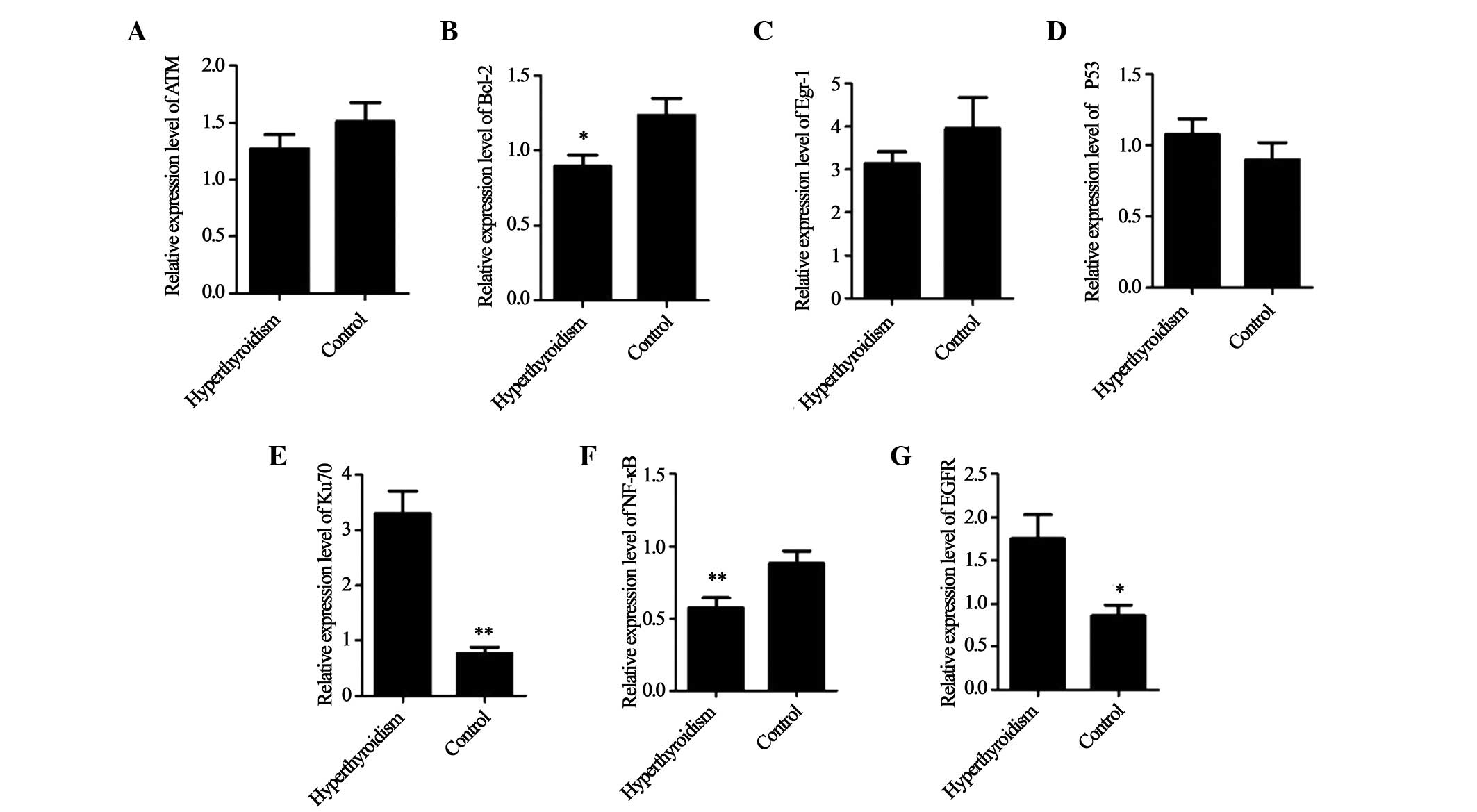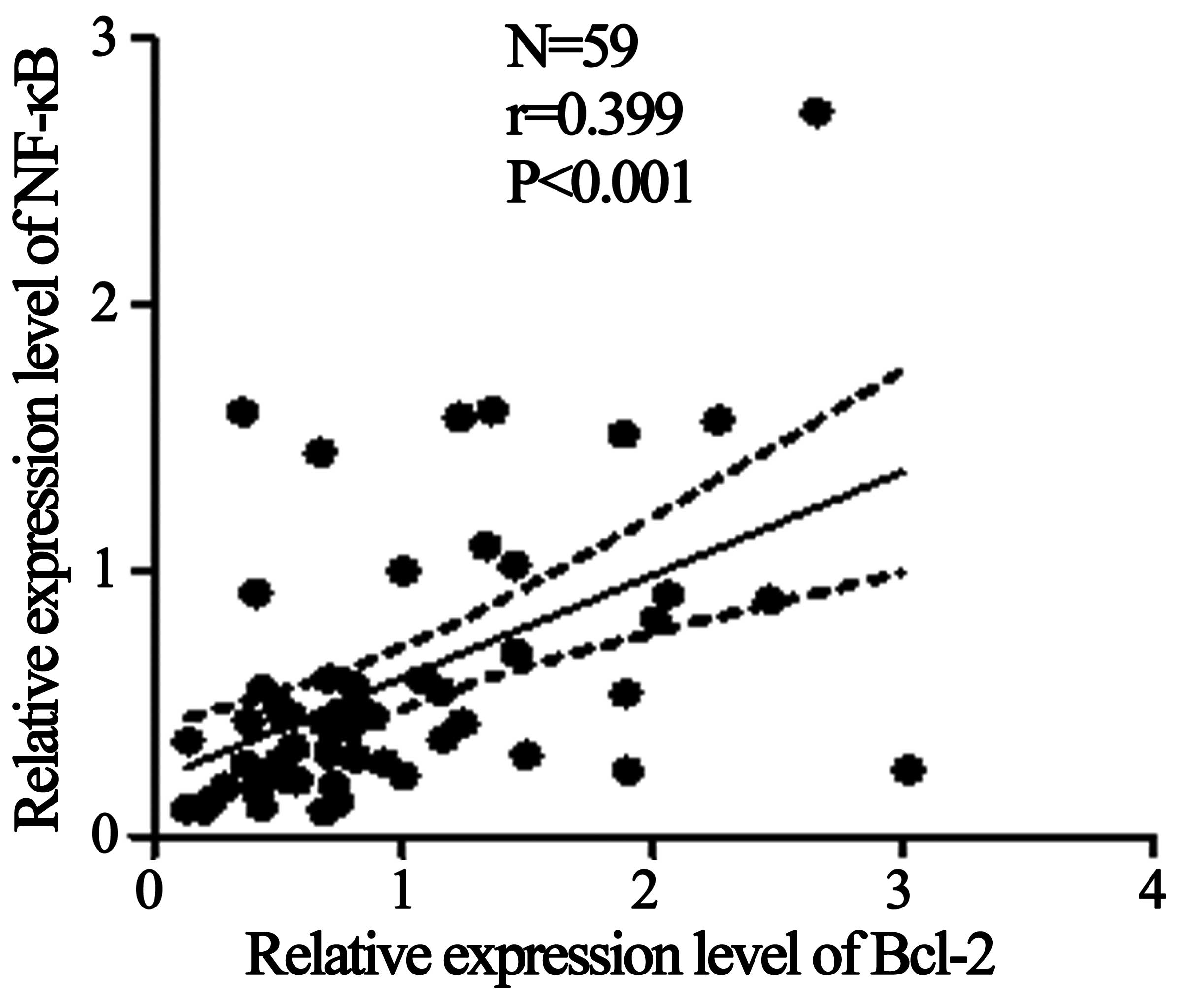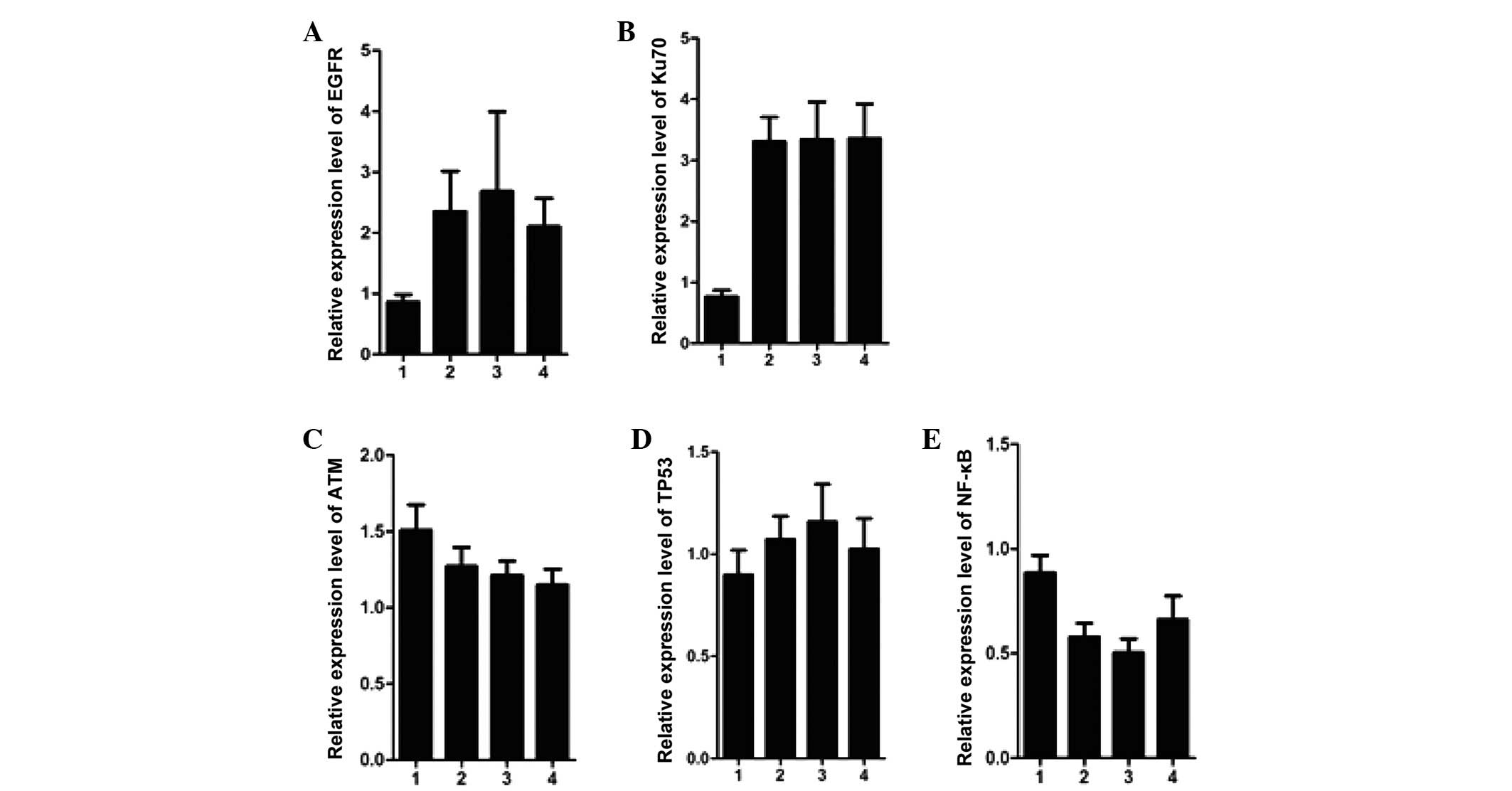|
1
|
Bahn Chair RS, Burch HB, Cooper DS, Garber
JR, Greenlee MC, Klein I, Laurberg P, McDougall IR, Montori VM,
Rivkees SA, et al American Thyroid Association; American
Association of Clinical Endocrinologists: Hyperthyroidism and other
causes of thyrotoxicosis: management guidelines of the American
Thyroid Association and American Association of Clinical
Endocrinologists. Thyroid. 21:593–646. 2011. View Article : Google Scholar : PubMed/NCBI
|
|
2
|
Vanderpump MP, Tunbridge WM, French JM,
Appleton D, Bates D, Clark F, Grimley Evans J, Hasan DM, Rodgers H,
Tunbridge F, et al: The incidence of thyroid disorders in the
community: A twenty-year follow-up of the Whickham survey. Clin
Endocrinol (Oxf). 43:55–68. 1995. View Article : Google Scholar
|
|
3
|
Klein I and Ojamaa K: Thyroid hormone and
the cardiovascular system. N Engl J Med. 344:501–509. 2001.
View Article : Google Scholar : PubMed/NCBI
|
|
4
|
Effraimidis G and Wiersinga WM: Mechanisms
in endocrinology: Autoimmune thyroid disease: Old and new players.
Eur J Endocrinol. 170:R241–R252. 2014. View Article : Google Scholar : PubMed/NCBI
|
|
5
|
Solomon B, Glinoer D, Lagasse R and
Wartofsky L: Current trends in the management of Graves' disease. J
Clin Endocrinol Metab. 70:1518–1524. 1990. View Article : Google Scholar : PubMed/NCBI
|
|
6
|
Wartofsky L, Glinoer D, Solomon B,
Nagataki S, Lagasse R, Nagayama Y and Izumi M: Differences and
similarities in the diagnosis and treatment of Graves' disease in
Europe, Japan and the united states. Thyroid. 1:129–135. 1991.
View Article : Google Scholar
|
|
7
|
Kraft O: Hypothyroidism and radioiodine
therapy. Cancer Biother Radiopharm. 22:261–267. 2007. View Article : Google Scholar : PubMed/NCBI
|
|
8
|
Berg GE, Michanek AM, Holmberg EC and Fink
M: Iodine-131 treatment of hyperthyroidism: Significance of
effective half-life measurements. J Nucl Med. 37:228–232.
1996.PubMed/NCBI
|
|
9
|
Catargi B, Leprat F, Guyot M, Valli N,
Ducassou D and Tabarin A: Optimized radioiodine therapy of Graves'
disease: Analysis of the delivered dose and of other possible
factors affecting outcome. Eur J Endocrinol. 141:117–121. 1999.
View Article : Google Scholar : PubMed/NCBI
|
|
10
|
de Jong JA, Verkooijen HM, Valk GD,
Zelissen PM and de Keizer B: High failure rates after 131I therapy
in graves hyperthyroidism patients with large thyroid volumes, high
iodine uptake and high iodine turnover. Clin Nucl Med. 38:401–406.
2013. View Article : Google Scholar : PubMed/NCBI
|
|
11
|
Anai S, Shiverick K, Medrano T, Nakamura
K, Goodison S, Brown BD and Rosser CJ: Downregulation of BCL-2
induces downregulation of carbonicanhydrase IX, vascular
endothelial growth factor and pAkt and induces radiation
sensitization. Urology. 70:832–837. 2007. View Article : Google Scholar : PubMed/NCBI
|
|
12
|
Schneider J, Illig T, Rosenberger A,
Bickeböller H and Wichmann HE: Detection of atm gene mutations in
young lung cancer patients: A population-based control study. Arch
Med Res. 39:226–231. 2008. View Article : Google Scholar : PubMed/NCBI
|
|
13
|
Kiyozuka M, Akimoto T, Fukutome M, Motegi
A and Mitsuhashi N: Radiation-induced dimer formation of EGFR:
Implications for the radiosensitizing effect of cetuximab.
Anticancer Res. 33:4337–4346. 2013.PubMed/NCBI
|
|
14
|
Akimoto T, Hunter NR, Buchmiller L, Mason
K, Ang KK and Milas L: Inverse relationship between epidermal
growth factor receptor expression and radiocurability of murine
carcinomas. Clin Cancer Res. 5:2884–2890. 1999.PubMed/NCBI
|
|
15
|
Vera-Badillo FE, Al-Mubarak M, Templeton
AJ and Amir E: Benefit and harms of new anti-cancer drugs. Curr
Oncol Rep. 15:270–275. 2013. View Article : Google Scholar : PubMed/NCBI
|
|
16
|
Ahmed MM, Venkatasubbarao K, Fruitwala SM,
Muthukkumar S, Wood DP Jr, Sells SF, Mohiuddin M and Rangnekar VM:
EGR-1 induction is required for maximal radiosensitivity in A375-C6
melanoma cells. J Biol Chem. 271:29231–29237. 1996. View Article : Google Scholar : PubMed/NCBI
|
|
17
|
Zagurovskaya M, Shareef MM, Das A, Reeves
A, Gupta S, Sudol M, Bedford MT, Prichard J, Mohiuddin M and Ahmed
MM: EGR-1 forms a complex with YAP-1 and upregulates Bax expression
in irradiated prostate carcinoma cells. Oncogene. 28:1121–1131.
2009. View Article : Google Scholar : PubMed/NCBI
|
|
18
|
Marinelli LD, Quimby EH and Hine GJ:
Dosage determination with radioactive isotopes. Nucleonics.
2:561948.PubMed/NCBI
|
|
19
|
Zhang W, Gao R, Yu Y, Guo K, Hou P, Yu M,
Liu Y and Yang A: Iodine-131 induces apoptosis in HTori-3 human
thyrocyte cell line and G2/M phase arrest in a p53-independent
pathway. Mol Med Rep. 11:3148–3154. 2015.
|
|
20
|
Erem C, Kandemir N, Hacihasanoglu A, Ersöz
HO, Ukinc K and Kocak M: Radioiodine treatment of hyperthyroidism:
prognostic factors affecting outcome. Endocrine. 25:55–60. 2004.
View Article : Google Scholar : PubMed/NCBI
|
|
21
|
Vaidya B, Williams GR, Abraham P and
Pearce SH: Radioiodine treatment for benign thyroid disorders:
results of a nationwide survey of UK endocrinologists. Clin
Endocrinol (Oxf). 68:814–820. 2008. View Article : Google Scholar
|
|
22
|
Nygarrd B, Hegedüs L, Gervil M, Hjalgrim
H, Hansen BM, Søe-Jensen P and Hansen JM: Influence of compensated
radioiodine therapy on thyroid volume and incidence of
hypothyroidism in Graves' disease. J Intern Med. 238:491–497. 1995.
View Article : Google Scholar
|
|
23
|
Sridama V, McCormick M, Kaplan EL, Fauchet
R and DeGroot LJ: Long-term follow-up study of compensated low-dose
13lI therapy for Graves' disease. N Engl J Med. 311:426–432. 1984.
View Article : Google Scholar : PubMed/NCBI
|
|
24
|
Farkasova T, Gurska S, Witkovsky V and
Gabelova A: Significance of amino acid substitution variants of DNA
repair genes in radiosusceptibility of cervical cancer patients; a
pilot study. Neoplasma. 55:330–337. 2008.PubMed/NCBI
|
|
25
|
Krempler A, Deckbar D, Jeggo PA and
Löbrich M: An imperfect G2M checkpoint contributes to chromosome
instability following irradiation of S and G2 phase cells. Cell
Cycle. 6:1682–1686. 2007. View Article : Google Scholar : PubMed/NCBI
|
|
26
|
Darzynkiewicz Z, Zhao H, Halicka HD, Rybak
P, Dobrucki J and Wlodkowic D: DNA damage signaling assessed in
individual cells in relation to the cell cycle phase and induction
of apoptosis. Crit Rev Clin Lab Sci. 49:199–217. 2012. View Article : Google Scholar : PubMed/NCBI
|
|
27
|
Mimori T, Akizuki M, Yamagata H, Inada S,
Yoshida S and Homma M: Characterization of a high molecular weight
acidic nuclear protein recognized by autoantibodies in sera from
patients with polymyositis-scleroderma overlap. J Clin Invest.
68:611–620. 1981. View Article : Google Scholar : PubMed/NCBI
|
|
28
|
Dobbs TA, Tainer JA and Lees-Miller SP: A
structural model for regulation of NHEJ by DNA-PKcs
autophosphorylation. DNA Repair (Amst). 9:1307–1314. 2010.
View Article : Google Scholar
|
|
29
|
Helmink BA and Sleckman BP: The response
to and repair of RAG-mediated DNA double-strand breaks. Annu Rev
Immunol. 30:175–202. 2012. View Article : Google Scholar : PubMed/NCBI
|
|
30
|
Otsuka K and Ochiya T: Genetic networks
lead and follow tumor development: microRNA regulation of cell
cycle and apoptosis in the p53 pathways. Biomed Res Int.
2014:7497242014. View Article : Google Scholar : PubMed/NCBI
|
|
31
|
Weixiao Z, Rui G, Yan Y, Kun G, Peng H,
Yan L and Mingqi Y: Iodine-131 induces apoptosis in the HTori 3
cell line and G2/M arrest in a p53-independent pathway. Mol Med
Rep. 11:3148–3154. 2015.
|
|
32
|
Kasai K, Kuroda H, Hashigami Y, Ishikawa
M, Nakamura T and Shimoda SI: Specific epidermal growth factor
receptors on porcine and human thyroid membranes. Horm Metab Res.
17:592–594. 1985. View Article : Google Scholar : PubMed/NCBI
|
|
33
|
Kanamori A, Abe Y, Yajima Y, Manabe Y and
Ito K: Epidermal growth factor receptors in plasma membranes of
normal and diseased human thyroid glands. J Clin Endocrinol Metab.
68:899–903. 1989. View Article : Google Scholar : PubMed/NCBI
|
|
34
|
Saller B, Stapfer G, Bein B, Hoermann R,
Spelsberg F and Mann K: Increased binding capacity of receptors for
the epidermal growth factor in benign thyroid nodules and thyroid
malignancies. Clin Investig. 71:898–902. 1993. View Article : Google Scholar : PubMed/NCBI
|
|
35
|
Westermark K, Karlsson FA and Westermark
B: Epidermal growth factor modulates thyroid growth and function in
culture. Endocrinology. 112:1680–1686. 1983. View Article : Google Scholar : PubMed/NCBI
|
|
36
|
Mizukami Y, Nonomura A, Michigishi T,
Yokoyama K, Noguchi M, Hashimoto T, Nakamura S and Matsubara F:
Immunohistochemical demonstration of epidermal growth-factor
receptors in normal, benign and malignant thyroid tissues. Int J
Oncol. 1:331–335. 1992.PubMed/NCBI
|
|
37
|
Marti U, Ruchti C, Kämpf J, Thomas GA,
Williams ED, Peter HJ, Gerber H and Bürgi U: Nuclear localization
of epidermal growth factor and epidermal growth factor receptors in
human thyroid tissues. Thyroid. 11:137–145. 2001. View Article : Google Scholar : PubMed/NCBI
|
|
38
|
Aggarwal BB, Takada Y, Shishodia S,
Gutierrez AM, Oommen OV, Ichikawa H, Baba Y and Kumar A: Nuclear
transcription factor NF-kappa B: Role in biology and medicine.
Indian J Exp Biol. 42:341–353. 2004.PubMed/NCBI
|
|
39
|
Nandakumar DN, Koner BC, Vinayagamoorthi
R, Nanda N, Negi VS, Goswami K, Bobby Z and Hamide A: Activation of
NF-kappaB in lymphocytes and increase in serum immunoglobulin in
hyperthyroidism: Possible role of oxidative stress. Immunobiology.
213:409–415. 2008. View Article : Google Scholar : PubMed/NCBI
|
|
40
|
Vinayagamoorthi R, Koner BC, Kavitha S,
Nandakumar DN, Padma Priya P and Goswami K: Potentiation of humoral
immune response and activation of NF-kappaB pathway in lymphocytes
in experimentally induced hyperthyroid rats. Cell Immunol.
238:56–60. 2005. View Article : Google Scholar
|
|
41
|
Kumar A, Sinha RA, Tiwari M, Singh R, Koji
T, Manhas N, Rastogi L, Pal L, Shrivastava A, Sahu RP and Godbole
MM: Hyperthyroidism induces apoptosis in rat liver through
activation of death receptor-mediated pathways. J Hepatol.
46:888–898. 2007. View Article : Google Scholar : PubMed/NCBI
|
|
42
|
Chen F, Castranova V and Shi X: New
insights into the role of nuclear factor-kappaB in cell growth
regulation. Am J Pathol. 159:387–397. 2001. View Article : Google Scholar : PubMed/NCBI
|
|
43
|
Mattson MP and Camandola S: NF-κB in
neuronal plasticity and neurodegenerative disorders. J Clin Invest.
107:247–254. 2001. View
Article : Google Scholar : PubMed/NCBI
|
|
44
|
Chen C, Edelstein LC and Gelinas C: The
Rel/NF-kappaB family directly activates expression of the apoptosis
inhibitor Bcl-x(L). Mol Cell Biol. 20:2687–2695. 2000. View Article : Google Scholar : PubMed/NCBI
|
|
45
|
Czabotar PE, Lessene G, Strasser A and
Adams JM: Control of apoptosis by the BCL-2 protein family:
Implications for physiology and therapy. Nat Rev Mol Cell Biol.
15:49–63. 2014. View
Article : Google Scholar
|
|
46
|
Klatka M, Grywalska E, Polak A and
Roliński J: Impact of treatment with methimazole on the Bcl-2
expression in CD8+ peripheral blood lymphocytes in children with
Graves' disease. Ann Agric Environ Med. 20:884–888. 2013.PubMed/NCBI
|
|
47
|
Giriş M, Erbil Y, Depboylu B, Mete O,
Türkoğlu U, Abbasoğlu SD and Uysal M: Heme oxygenase-1 prevents
hyperthyroidism induced hepatic damage via an antioxidant and
antiapoptotic pathway. J Surg Res. 164:266–275. 2010. View Article : Google Scholar
|














